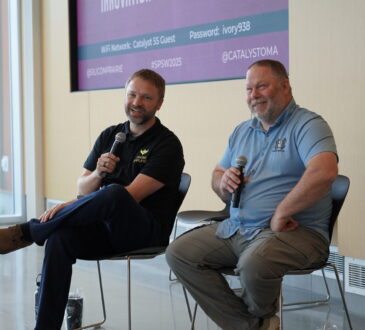
- The word “entrepreneur” overtook “small business” in English-language use in 2010, and has grown since, reflecting how identity has shifted from “owner” to “builder.”
- The US Census Bureau counted nearly 170,000 new high-propensity business applications in August 2025, continuing the post-pandemic surge.
- Coming data updates will exclude internet-sales filings, clarifying which new firms are most likely to hire — but the long-term entrepreneurship boom looks durable.
Maria Meyers has an on-again, off-again relationship with entrepreneurship.
She has a job: She’s the executive director of the University of Missouri–Kansas City’s Innovation Center. But among certain local economic development circles, she’s as steeped in business starts as anyone. In 2003, she founded SourceLink, a category-defining nonprofit that provides software and services to track and connect resources for entrepreneurs in an “ecosystem,” a term of art for a geographically-bounded mix of innovation makers.
“Entrepreneur has become sort of a badge of courage.”
Maria Meyers, UMKC Innovation Center
“Entrepreneur has become sort of a badge of courage,” Meyers told me. “People running bakeries or a lawn-mowing business call themselves entrepreneurs.”
The French-origin word gained English usage during the 19th century industrial age. But Americans got hooked during the internet-powered era of the 1990s that continued on through the Great Recession — reflecting a shift from the stasis of ownership to the agency of building. English-language books used the word “entrepreneur” more than “small business” for the first time on record in 2010, per Google Books. The trend has continued.
Though more may be using the same identifier, not all businesses are the same. Meyers puts them in four categories, relying on a common research methodology:
- Most are “microenterprise,” or those with few or no employees
- About 1 in 4 are “Main Streeters,” like restaurants and hardware stores
- About 3% are “second-stage,” or established firms going through a growth period
- Just 1% are “innovation-led,” or those backed by new science, technology or some other breakthrough
“Every one of these different types of business can be funded differently,” Meyers said. Americans have started a lot of all of them, ever since the pandemic. Just in August, nearly 170,000 new “high-propensity” businesses were filed, according to the Census Bureau. That’s a distinction the federal government uses to describe firm types that are likely to hire employees. Amid a souring economic mood, this is a bright light, and a signal that Americans are creating their own refuge.
“Understanding how they identify is important,” Meyers said. “You have to ask the entrepreneur where they want to go to figure out the right resources.”
Ready for investors? A tighter follow-on market and more demand for de-risking
That’s where investor readiness enters. The phrase can sound like pitch-deck theater, but it’s a serious discipline, argues Anthony Millin, founder and co-chair of NEXT powered by Shulman Rogers, a platform for connecting entrepreneurs to resources housed within a law firm.
Millin’s focus is more on those innovation and growth-stage firms, rather than solopreneurs or services businesses. Break-through firms matter: Just this week the Nobel Prize in economics honored decades of work on the economic centrality of “creative destruction.”
Even beyond high-minded economic reasons, there are tactical reasons to better match different types of entrepreneurs with the right type of funding: Outside capital is typically reserved for speeding up a business bet on an emerging or fast-changing market.
“What you’re really talking about is being ready for this process of going out and raising capital,” Millin said. The unglamorous work starts early. His three familiar tips:
- “Pick the right investors to be in the room with. Be aligned in stage and aligned in sector focus.”
- “Make sure all your foundational legal documents are solid. And set up your legal data room on day one so due diligence follows a clear checklist.”
- “Have a financial model and be ready to explain the assumptions. How much are you looking to raise and why, with 12–24 months of runway.”
All are backed by a growing library of online resources — from books and blog posts to podcasts and Youtube videos. Gobs of advice out there is credible, per Millin, but the benchmarks have changed in the madness of the pandemic, and the current AI hype cycle.
“Everything has shifted,” he said of raising venture capital in particular, citing a tighter follow-on market and investors demanding more de-risking at each step. “What used to get you to a Series B now gets you to a Series A.”
His guidance for defining your investable business: pre-seed financing tests a problem; seed-stage tests a solution and a Series A grows that solution.
As ever, he reminds, though venture capital became glamorous, VC is not the only game. Depending on your “type” (hello, Maria’s business categories), capital might come from angels, crowdfunding, grants, revenue-based financing or even bank lines once profitable.
Data shows formidable US business growth, though definitions are changing
All of this sits against a still-remarkable entrepreneurship boom: Nearly half a million total business applications in August, per the Census, including those most likely to grow. It’s messy out there though. The metrics are still reliable, but the federal government’s data-collection services are under siege.
Meanwhile early could-be AI productivity gains and well-entrenched online habits muddy historical comparison. Beginning with the November 2025 monthly release on business starts, the Census Bureau will drop applications associated with internet sales from their high-propensity business count. Once a clear signal of innovation-fueled hiring, ecommerce is now filled with tiny operations.
Historical definitions will be updated across the time series, so data will shift. But that seems unlikely to erase recent years entrepreneurship gains, backed by people like Millin and Meyers.
“Every entrepreneur uses different resources, and we need them all,” Meyers said. At the foundation, though, “Entrepreneurship is starting something new, and helping it grow”




